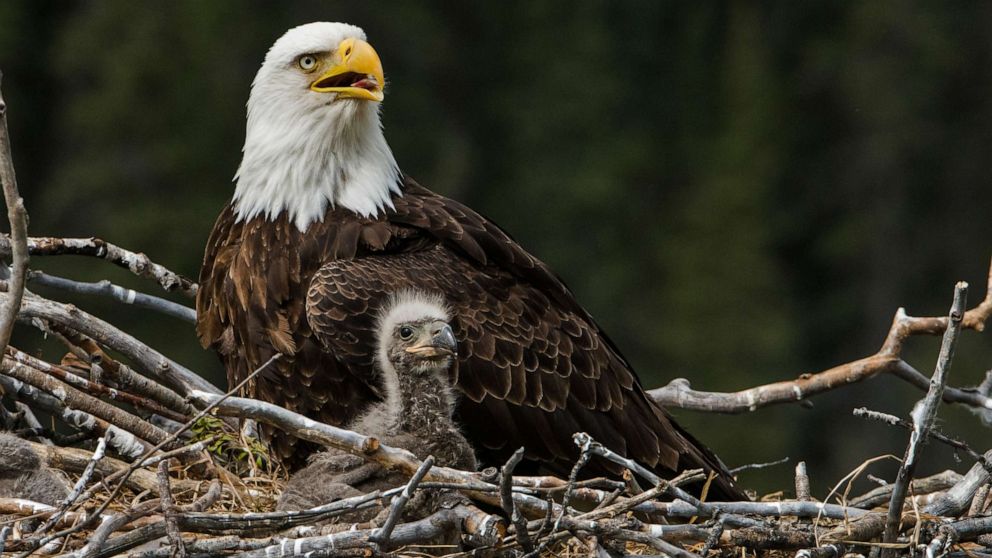Eagles: Masters of the Sky
Introduction
Eagles, the majestic birds of prey, have captured the imagination of humans for centuries. With their powerful beaks, sharp talons, and keen eyesight, eagles are not just birds; they are symbols of power, freedom, and grace.
Taxonomy of eagles:
- Kingdom: Animalia (Animals)
- Phylum: Chordata (Chordates)
- Class: Aves (Birds)
- Order: Accipitriformes (Birds of Prey)
- Family: Accipitridae (Hawks, Eagles, Kites, Harriers)
- Genus: Various genera (e.g., Aquila, Haliaeetus)
- Species: Numerous species within the genera

Number of Species:
The eagle family boasts an impressive diversity, with over 60 species identified worldwide. Each species exhibits unique characteristics, adaptations, and behaviors, contributing to the rich tapestry of avian biodiversity.

Habitat and Diet:
Habitat:
- Mountainous Regions:
- Some eagle species, like the Golden Eagle, thrive in mountainous terrain. They nest on cliffs and soar over vast expanses of rugged landscapes.
- Forest Dwellers:
- Species such as the Harpy Eagle are adapted to life in dense tropical rainforests. The canopy provides them with both nesting sites and hunting grounds.
- Coastal Environments:
- Coastal areas are home to certain eagles, like the Bald Eagle. They flourish near lakes, rivers, and coastal waters, where they can find fish and other aquatic prey.
- Open Plains and Savannahs:
- Eagles like the African Fish Eagle may inhabit open plains and savannahs, using their keen eyesight to spot prey from elevated perches.
- Arctic Regions:
- The White-tailed Eagle and other species are found in colder climates, including Arctic regions. They are adapted to hunting in icy waters for fish.
- Grasslands and Deserts:
- Some eagle species, like the Tawny Eagle, are well-suited to grasslands and deserts. They hunt small mammals and birds in these open environments.
- Urban Areas:
- In certain cases, eagles have adapted to urban environments. They may utilize tall structures as substitutes for cliffs and hunt amidst human habitation.

Diet:
- Fish-Eating Eagles:
- Species like the Osprey and Bald Eagle are renowned for their piscivorous habits, preying primarily on fish near bodies of water.
- Birds as Prey:
- Eagles are skilled avian hunters. They may target birds of various sizes, from small songbirds to larger waterfowl.
- Mammalian Prey:
- Small to medium-sized mammals form a significant part of the diet for many eagles. This includes rodents, hares, and even larger mammals depending on the eagle’s size.
- Reptiles and Amphibians:
- Eagles are known to prey on reptiles and amphibians. Snakes and amphibians near water sources are particularly vulnerable.
- Carrion Consumption:
- While primarily hunters, eagles are opportunistic feeders. They readily consume carrion, scavenging on the remains of other animals.
- Insects and Invertebrates:
- Juvenile eagles and some smaller species may include insects and invertebrates in their diet, especially during the early stages of life.
Understanding the diverse habitats and diets of eagles provides insight into their ecological roles and the adaptations that have allowed them to thrive in various environments.
Eagle Vision:
Eagles possess extraordinary vision, a key adaptation for their predatory lifestyle:
- Keen Eyesight:
- Eagles can see with remarkable clarity, up to four to five times better than humans.
- Binocular Vision:
- Their eyes are positioned on the front of their faces, providing binocular vision for enhanced depth perception.
- Zooming Capability:
- Eagles can adjust the curvature of their lenses, acting like a zoom lens, allowing them to focus on distant objects with incredible detail.
- Infrared Sensitivity:
- Some eagles have a degree of infrared sensitivity, useful for detecting heat variations, especially in hunting warm-blooded prey.

Nesting Behaviors:
Eagle nesting behaviors are intricate and vital for the survival of their offspring:
- Architectural Marvels:
- Eagles construct large nests, often high in trees or on cliffs, using sticks and vegetation. Some nests can be reused for several breeding seasons.
- Collaborative Nesting:
- Mates work together in the construction and maintenance of the nest, showcasing cooperation and reinforcing their bond.
- Territorial Attachment:
- Nests serve as territorial markers, and eagles fiercely defend their nesting sites from intruders, including other eagles.
- Reuse and Expansion:
- Many eagles reuse the same nest, gradually expanding and reinforcing it over the years. Some nests reach impressive sizes, with depths exceeding 20 feet.
- Strategic Placement:
- Nesting sites are strategically chosen for safety and proximity to food sources, such as cliffs for vantage points or trees for concealment.
- Maternal Incubation:
- Females take the lead in incubating the eggs, while males contribute to nest defense and hunting for the pair.
- Parental Care:
- Both parents play active roles in feeding and protecting the eaglets after hatching, fostering a strong sense of parental care.

Mating Rituals of Eagles:
Monogamy:
- Eagles are known for their tendency to form monogamous pairs, and many species stay with the same mate for multiple breeding seasons. This enduring partnership is a crucial aspect of their social structure.
Conservation Challenges: Protecting the Majestic Raptors
Despite their powerful presence, eagles face conservation challenges. Habitat loss, human disturbance, and pollution pose threats to their survival. Conservation efforts are crucial to ensuring these majestic birds continue to soar the skies.
- Habitat Loss:
- Urbanization and deforestation threaten the natural habitats of eagles, limiting their breeding and hunting grounds.
- Human Disturbance:
- Increased human activities, including recreational pursuits and tourism, can disturb nesting sites and affect the behavior of these birds.
- Pollution:
- Eagles, especially those reliant on aquatic habitats, face threats from pollutants such as pesticides and heavy metals, impacting their health and reproductive success.
- Climate Change:
- Altered weather patterns and habitat shifts due to climate change can disrupt the delicate ecological balance eagles depend on.
- Collision Risks:
- Collisions with power lines and structures pose a significant threat, leading to injuries or fatalities among eagle populations.
Conservation efforts are crucial to mitigating these challenges and ensuring the continued survival of these iconic birds.

Interesting facts about eagles:
| Eagles have exceptional eyesight, up to 5 times better than humans. |
| The Harpy Eagle boasts the largest talons of any eagle species. |
| Eagles can reach impressive speeds during flight, with some species exceeding 150 mph (240 km/h). |
| The Philippine Eagle, among the rarest eagles, has a wingspan of up to 2.2 meters. |
| Bald Eagles are known for their distinctive white heads and tails, appearing bald from a distance. |
| Some eagle species, like the African Fish Eagle, are adept at catching fish, their primary prey. |
| The conservation status of eagles varies; some, like the Bald Eagle, have made successful comebacks after facing endangerment. Eagles have a lifespan ranging from 20 to 30 years, depending on the species. |
